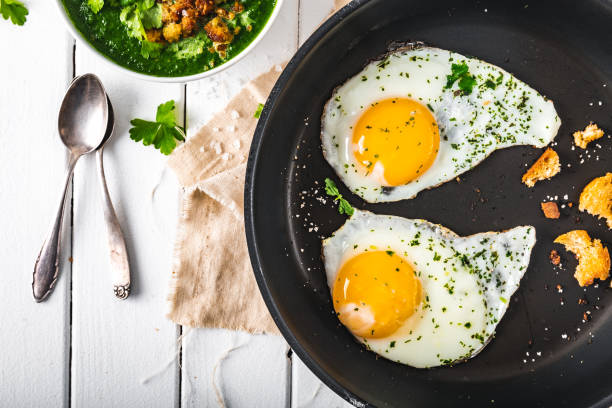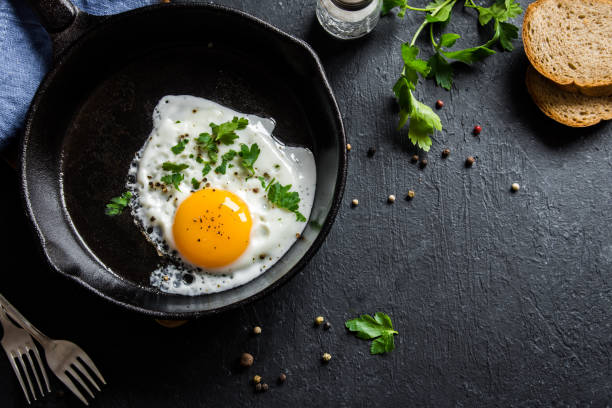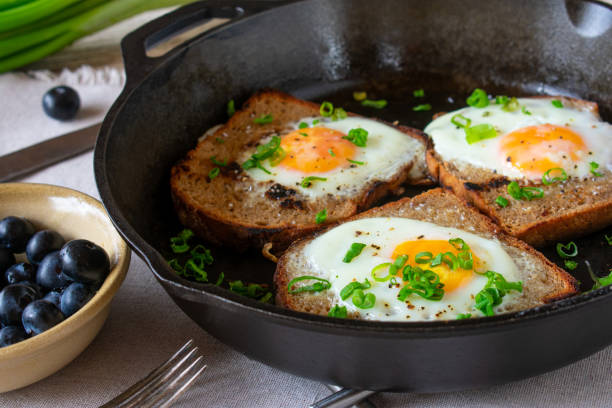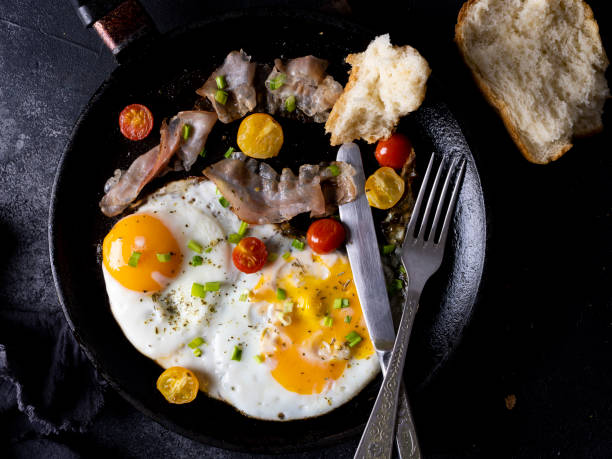In the mysterious world of culinary curiosities, few enigmas capture the attention of home chefs quite like the perplexing phenomenon of eggs turning green in aluminum pans.
Picture this: you’re innocently whisking away in your kitchen, preparing a delightful breakfast feast, only to be met with the unexpected surprise of green-hued eggs. It’s not a culinary experiment gone wrong, nor is it a quirky avant-garde recipe.
The science behind this color metamorphosis is as intriguing as it is elusive, shrouded in the alchemical dance between eggs and aluminum. Join us on a journey to uncover the secrets of this chromatic culinary spectacle, where science meets the skillet in a captivating tale of transformation.

Why Do Eggs Turn Green In Aluminum Pans
Eggs can turn green in aluminum pans due to a chemical reaction between the eggs and the aluminum.
When exposed to certain conditions, such as high heat and acidity, aluminum can leach into the food, causing a reaction that results in a greenish color on the egg whites. This phenomenon is harmless but may affect the aesthetic appeal of the eggs.
The Culprit – Aluminum and Acidity
In the world of culinary mysteries, the curious case of green eggs finds its roots in the interaction between aluminum and acidity.
Aluminum pans, when subjected to acidic ingredients like tomatoes or vinegar, release aluminum ions. This interaction, exacerbated by the heat, creates a chemical reaction with the egg whites, leading to the unexpected green tint.
The Chemistry Behind the Green Hue
Delving deeper into the science, the greenish discoloration occurs due to the formation of a complex compound involving aluminum and sulfur compounds present in the eggs. This chemical reaction alters the structure of the egg proteins, resulting in a visual transformation that can leave even seasoned cooks scratching their heads.
Harmless Yet Puzzling
Despite its unusual appearance, the green coloration is entirely harmless. The reaction alters the egg’s appearance but does not compromise its taste or safety. It’s a quirk of chemistry rather than a cause for concern, reassuring those who may encounter this culinary surprise in their aluminum-cooked creations.
Prevention and Kitchen Wisdom
To prevent the egg-aluminum chemistry experiment, consider using alternative cookware like stainless steel or non-stick pans when working with acidic ingredients. Additionally, reducing the cooking temperature and avoiding prolonged exposure can help minimize the likelihood of your eggs taking on an unexpected hue.
Common Culinary Conundrums
While the green eggs phenomenon might seem peculiar, it joins the ranks of other culinary mysteries that leave home chefs pondering. From the science of soufflés to the art of achieving the perfect poached egg, the world of cooking is filled with fascinating phenomena that continue to intrigue and inspire.
Eggs Turn Green Due to Chemical Change in Aluminum Pan
Eggs turning green in an aluminum pan is a fascinating phenomenon attributed to a chemical change that occurs during the cooking process. To unravel this culinary mystery, let’s break down the steps leading to the green tint.
Firstly, it’s crucial to understand that aluminum pans, commonly used in kitchens for their lightweight and efficient heat conduction properties, can react with certain foods. Eggs, in particular, contain compounds like sulfur and iron, which can instigate a chemical reaction when in contact with the aluminum surface.
When eggs are exposed to the heat of the aluminum pan, the sulfur compounds in the egg whites undergo a reaction with the metal. This reaction is known as a redox reaction, where electrons are transferred between the aluminum and sulfur compounds, leading to the formation of aluminum sulfide.
Aluminum sulfide is the culprit behind the green discoloration of the eggs. This compound is characterized by its greenish hue, imparting the color to the cooked eggs.
The reaction is more likely to occur in pans that are scratched or have worn-out surfaces, providing increased contact between the egg and the aluminum.
To prevent this color change, using alternative cookware such as stainless steel or non-stick pans is advisable. Additionally, ensuring the pan is in good condition without scratches minimizes the likelihood of the chemical reaction taking place.

Chicken Diet and Egg Yolks
Understanding the connection between a chicken’s diet and the quality of its egg yolks is essential for both poultry farmers and consumers seeking nutritious eggs. The dietary choices for chickens play a pivotal role in shaping the nutritional content of egg yolks.
Chickens are omnivores, and their diet influences the composition of the eggs they produce. A diet rich in nutrients such as omega-3 fatty acids, vitamins, and minerals tends to yield eggs with enhanced nutritional value.
For instance, chickens fed with a diet high in omega-3-rich foods like flaxseeds or fish oil will lay eggs containing elevated levels of these heart-healthy fats.
The vibrant yellow or orange color of egg yolks is often associated with the presence of carotenoids, pigments found in certain plants.
A chicken’s diet, particularly one including foods like marigold petals or corn, which are high in carotenoids, can result in deeply colored yolks. The intensity of the yolk color is not only visually appealing but also indicative of the nutritional content.
In contrast, a monotonous or low-nutrient diet may lead to paler yolks. Chickens that lack access to a diverse range of foods might produce eggs with lower concentrations of essential nutrients. To optimize egg quality, providing chickens with a balanced and varied diet is crucial.
Consumers can benefit from eggs with rich, colorful yolks, as these often indicate higher levels of nutrients such as vitamins A and D, and omega-3 fatty acids. When purchasing eggs, checking labels or opting for those labeled as “omega-3 enriched” can be a simple way to ensure a higher nutritional profile.
Green Rings and Egg Yolks
The occurrence of green rings around hard-boiled egg yolks is a result of a chemical reaction between the iron in the yolk and sulfur in the egg white. This reaction is facilitated by excessive cooking or prolonged exposure to high temperatures, typically during the boiling process.
When eggs are boiled, the iron in the yolk reacts with hydrogen sulfide, a compound present in the egg white. This reaction forms ferrous sulfide, a compound that appears as a greenish-gray ring encircling the yolk.
While this reaction does not pose any health risks, it can negatively impact the visual appeal and taste of the egg.
To minimize the likelihood of green rings, it’s essential to avoid overcooking eggs. Overcooking leads to the breakdown of sulfur-containing proteins in the egg white, increasing the availability of hydrogen sulfide for the reaction with iron in the yolk.
Ideally, hard-boiled eggs should be cooked until the yolks are just set, without prolonged boiling.
Additionally, rapidly cooling the eggs after boiling can help prevent the green ring formation. Placing the boiled eggs in an ice bath or running cold water over them can halt the chemical reaction and ensure the yolks retain their natural color and flavor.

Aged Eggs vs. Fresh Eggs
Distinguishing between aged and fresh eggs involves considering various factors, including appearance, composition, and culinary characteristics. These differences arise due to changes in the egg over time, influenced by factors such as storage conditions and the natural aging process.
1. Shell Appearance
Fresh eggs typically have clean, smooth, and slightly glossy shells. As eggs age, the protective coating on the shell wears off, making them more porous and susceptible to absorbing odors. Aged eggs may exhibit a duller appearance with a potential for staining.
2. Egg White Consistency
Fresh egg whites are thick and firm, making them ideal for recipes that require a stable structure, such as meringues. As eggs age, the protein structure in the whites weakens, leading to thinner, more watery consistency. While still suitable for most culinary uses, aged egg whites might not achieve the same volume as their fresher counterparts.
3. Yolk Appearance
The yolk of a fresh egg is typically plump and stands tall. Over time, the yolk membrane weakens, causing the yolk to flatten and spread. This change doesn’t affect the taste or nutritional value but may impact the aesthetic appeal in certain dishes.
4. Culinary Uses
Fresh eggs are often preferred for recipes where structure and leavening properties are crucial, such as in baking cakes or making soufflés. Aged eggs, on the other hand, may be preferred for hard-boiling, as they are easier to peel when the pH of the whites is slightly higher.
5. Egg Float Test
One simple way to check the freshness of an egg is the float test. Fresh eggs sink to the bottom when placed in water, while older eggs tend to stand upright or float due to the enlarging air cell inside.
6. Storage Conditions
Proper storage is key to maintaining egg freshness. Refrigeration helps slow down the aging process, and eggs stored in their original carton with the pointed end down tend to stay fresh longer.
Preventing the Eggs from Changing Color during the Cooking Process
Preventing eggs from changing color during the cooking process is possible by taking certain precautions and following best practices.
The discoloration often occurs due to chemical reactions involving compounds in the egg whites and yolks. Here are some tips to maintain the natural color of eggs while cooking:
1. Use Fresh Eggs
Start with fresh eggs, as they are less likely to undergo chemical changes that lead to discoloration. Check the expiration date and select eggs that are within their recommended freshness period.
2. Avoid Aluminum Cookware
Refrain from using aluminum pans or cookware, as these can react with the sulfur compounds in eggs, causing them to change color. Opt for stainless steel, non-stick, or other cookware that doesn’t react with the egg components.
3. Monitor Cooking Time
Avoid overcooking eggs, as prolonged exposure to high temperatures can intensify chemical reactions and lead to color changes. Hard-boil eggs just until the yolks are set to minimize the risk of discoloration.
4. Use Acidic Ingredients
Adding acidic ingredients like vinegar or lemon juice to the cooking water can help prevent color changes in eggs. The acidity counteracts the alkaline environment that contributes to discoloration.
5. Quickly Cool Eggs
Immediately cool the eggs after cooking to halt any ongoing chemical reactions. Plunge boiled eggs into an ice bath or run cold water over them to rapidly lower their temperature.
6. Store Eggs Properly
eggs in the refrigerator to slow down the natural aging process. Keeping them in their original carton with the pointed end down helps maintain freshness and reduces the risk of discoloration.
7. Consider Cooking Methods
Experiment with different cooking methods that are less likely to cause discoloration. Steaming or poaching eggs, for example, may result in less color change compared to boiling.
8. Avoid High pH Water
If you are boiling eggs, use water with a slightly acidic pH. This can be achieved by adding a small amount of vinegar to the boiling water, which helps maintain the stability of egg whites.

Scrambled Eggs and Cast Iron Skillets
Cooking scrambled eggs in a cast iron skillet can elevate the dish, offering a unique flavor and texture. The cast iron’s even heat distribution and the ability to retain heat make it an excellent choice for preparing these classic breakfast eggs. Here’s how to achieve perfect scrambled eggs in a cast iron skillet:
1. Preheat the Cast Iron Skillet
Place the cast iron skillet on the stove and preheat it over medium-low heat. Allow the skillet to gradually come to temperature to ensure even cooking.
2. Add Fat
Once the skillet is heated, add a small amount of fat, such as butter, oil, or a combination of both. Allow the fat to melt and coat the surface of the skillet evenly.
3. Beat Eggs
In a bowl, beat the eggs until well combined. Season with salt and pepper according to your taste preferences. You can also add a splash of milk or cream for added creaminess.
4. Pour Eggs into Skillet
Pour the beaten eggs into the preheated, greased cast iron skillet. The even heat distribution of the skillet ensures that the eggs cook uniformly.
5. Cook Gently
Use a spatula to gently stir the eggs as they begin to set. The cast iron retains heat well, so you can cook the eggs at a slightly lower temperature, allowing for a more controlled and delicate cooking process.
6. Avoid Overcooking
Keep a close eye on the eggs to prevent overcooking. Cast iron skillets retain heat even after removing them from the stove, so it’s crucial to transfer the eggs to a plate just before they reach your desired level of doneness.
7. Season and Serve
Season the scrambled eggs with additional salt and pepper if needed. Consider adding fresh herbs, cheese, or other ingredients of your choice for extra flavor. Serve the eggs immediately while they are hot and tender.
8. Care for Your Cast Iron
After cooking, clean the cast iron skillet carefully. Avoid using harsh soaps or scrubbers, as they can strip the skillet’s seasoning. Instead, use a soft brush or cloth to clean, and re-season the skillet periodically to maintain its non-stick properties.

FAQs
Why do eggs sometimes appear green when cooked in aluminum pans?
Rest assured, the greenish tint is harmless and occurs due to a natural reaction between the acids in the eggs and the aluminum. It doesn’t affect the taste or nutritional value of your eggs.
Is it safe to eat eggs that turn green in aluminum pans?
Absolutely! The color change is only superficial and doesn’t indicate spoilage. Your eggs are perfectly safe to eat, and the greenish hue won’t alter the flavor.
Can I prevent my eggs from turning green in aluminum pans?
Certainly! To minimize the likelihood of discoloration, try using non-reactive cookware like stainless steel or nonstick pans. Adjusting cooking times and temperatures can also help maintain the natural color of your eggs.
Are there any benefits to cooking eggs in aluminum pans despite the color change?
Indeed! Aluminum pans are excellent heat conductors, allowing for even cooking and quick heat distribution. While the green tint may be a minor aesthetic concern, the benefits of efficient cooking are worth it.
Does the green color affect the nutritional content of the eggs?
No need to worry! The greenish discoloration has no impact on the nutritional value of your eggs. You can still enjoy a nutritious meal without any compromise.
Can the green color be used as an indicator of doneness?
While not a reliable method, the color change may signal that your eggs are fully cooked. It’s always best to rely on traditional methods like checking the texture or using a thermometer to ensure they’re cooked to perfection.
How can I clean the green residue from my aluminum pans?
Fear not! The green discoloration is usually a surface phenomenon and can be easily cleaned with mild dish soap and a non-abrasive sponge. Your pans will be sparkling clean in no time.
Are there alternative cookware options to avoid the green color change?
Certainly! If you’re keen on avoiding the green tint, consider using ceramic, glass, or cast iron pans. These materials are non-reactive and won’t cause any discoloration.
Does the green color affect the taste of the eggs?
Not at all! The greenish tint is purely cosmetic and won’t alter the taste of your eggs. You can continue to enjoy your favorite egg dishes without any concerns about flavor changes.
Can I use aluminum pans for other types of cooking without experiencing discoloration?
Absolutely! The green color change is most common when cooking acidic foods like eggs. For other dishes, aluminum pans remain a versatile and effective choice in the kitchen.
Conclusion:
In conclusion, the mysterious phenomenon of eggs turning green in aluminum pans can be attributed to a chemical reaction between the acids in the eggs and the aluminum surface.
When exposed to heat, the aluminum can react with sulfur compounds present in the eggs, forming a harmless but visually striking greenish discoloration.
While this reaction may raise eyebrows in the kitchen, it is essential to note that the color change poses no harm to the edibility or nutritional value of the eggs.
Understanding the science behind this occurrence allows cooks and enthusiasts to embrace the quirks of culinary chemistry, fostering a greater appreciation for the intricate interactions between ingredients and cooking surfaces.